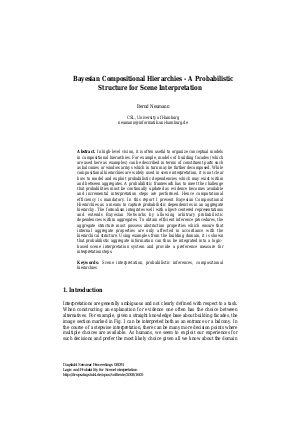Bayesian Compositional Hierarchies - A Probabilistic Structure for Scene Interpretation
Author Bernd Neumann
-
Part of:
Volume:
Dagstuhl Seminar Proceedings, Volume 8091
Part of: Series: Dagstuhl Seminar Proceedings (DagSemProc) - License:
 Creative Commons Attribution 4.0 International license
Creative Commons Attribution 4.0 International license
- Publication Date: 2008-10-23
File

PDF
DagSemProc.08091.6.pdf
- Filesize: 110 kB
- 16 pages
Document Identifiers
Subject Classification
Keywords
- Scene interpretation
- compositional hierarchy
- probabilistic inference
Metrics
- Access Statistics
-
Total Accesses (updated on a weekly basis)
0PDF Downloads0Metadata Views
Abstract
In high-level vision, it is often useful to organize conceptual models in compositional hierarchies. For example, models of building facades (which are used here as examples) can be described in terms of constituent parts such as balconies or window arrays which in turn may be further decomposed. While compositional hierarchies are widely used in scene interpretation, it is not clear how to model and exploit probabilistic dependencies which may exist within and between aggregates. In this contribution I present Bayesian Aggregate Hierarchies as a means to capture probabilistic dependencies in a compositional hierarchy. The formalism integrates well with object-centered representations and extends Bayesian Networks by allowing arbitrary probabilistic dependencies within aggregates. To obtain efficient inference procedures, the aggregate structure must possess abstraction properties which ensure that internal aggregate properties are only affected in accordance with the hierarchical structure. Using examples from the building domain, it is shown that probabilistic aggregate information can thus be integrated into a logic-based scene interpretation system and provide a preference measure for interpretation steps.
Cite As Get BibTex
Bernd Neumann. Bayesian Compositional Hierarchies - A Probabilistic Structure for Scene Interpretation. In Logic and Probability for Scene Interpretation. Dagstuhl Seminar Proceedings, Volume 8091, pp. 1-16, Schloss Dagstuhl – Leibniz-Zentrum für Informatik (2008)
https://doi.org/10.4230/DagSemProc.08091.6
BibTex
@InProceedings{neumann:DagSemProc.08091.6,
author = {Neumann, Bernd},
title = {{Bayesian Compositional Hierarchies - A Probabilistic Structure for Scene Interpretation}},
booktitle = {Logic and Probability for Scene Interpretation},
pages = {1--16},
series = {Dagstuhl Seminar Proceedings (DagSemProc)},
ISSN = {1862-4405},
year = {2008},
volume = {8091},
editor = {Anthony G. Cohn and David C. Hogg and Ralf M\"{o}ller and Bernd Neumann},
publisher = {Schloss Dagstuhl -- Leibniz-Zentrum f{\"u}r Informatik},
address = {Dagstuhl, Germany},
URL = {https://drops.dagstuhl.de/entities/document/10.4230/DagSemProc.08091.6},
URN = {urn:nbn:de:0030-drops-16050},
doi = {10.4230/DagSemProc.08091.6},
annote = {Keywords: Scene interpretation, compositional hierarchy, probabilistic inference}
}
